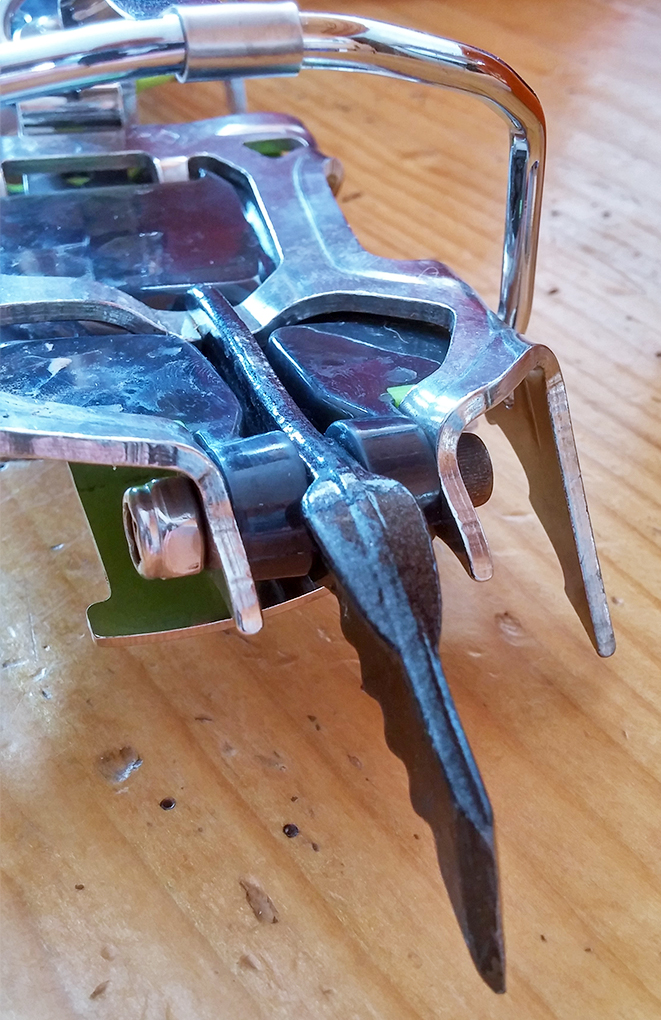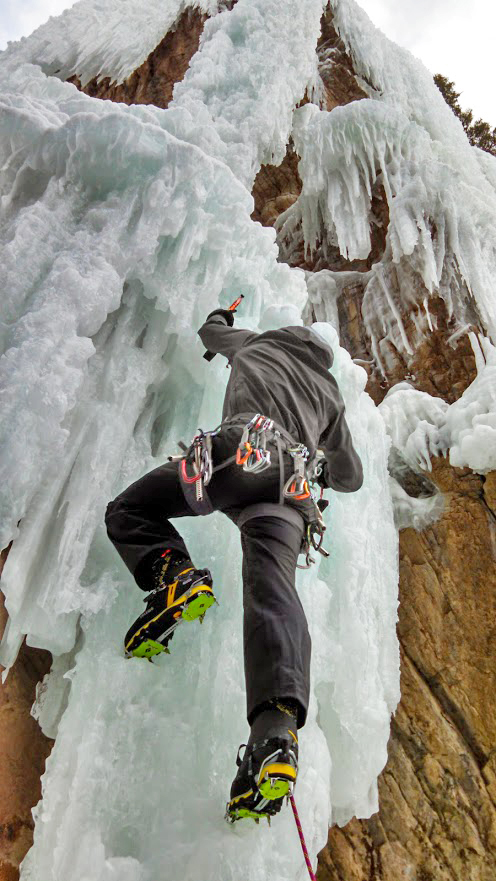Gripes
Relative to the other monopoint crampons I’ve mentioned, the Stinger has two minor shortcomings. The first is that its secondary frontpoints (pictured below) are very short and don’t engage effectively. They’re small enough that Black Diamond could easily do away with them entirely, but I’d rather see them lengthened a little bit so that they engage to some degree.
The Grivel Rambo 4 and Camp Bladerunner’s secondary frontpoints offer significantly more stability, and even the Grivel G20’s single secondary frontpoint offers more functionality than the Stinger’s two little ones. In this way, like the Petzl Dart, the Stinger functions as a “true monopoint” in that only its main frontpoint engages meaningfully.

My second (rather small) gripe with the Stinger concern its anti-bot plates (the plates or rubber pieces on the underside of crampons that aim to prevent snow from accumulating underfoot). The Stinger’s anti-bot plates are good, but they’re not great; by comparison, the convex rubber anti-bot plates on the Rambo 4 are far superior.
It seems like this would be an easy fix to make (which is why I’m bothering to mention it), but the Stinger is built for steep, technical ice and mixed climbing, so ultimately it isn’t as much of an issue as it would be on a pair of mountaineering crampons. (In the alpine realm, too much snow accumulation in the space between your spikes and the snow can be a real danger, as it may prevent the crampon from digging in fully.)
Praises
With those gripes aside, the Stinger does have some real strong points.
Foremost among them is that the frontpoint on the Stinger can be replaced as a single part for $14 per frontpoint. The Grivel Rambo 4 is similar in that replacement frontpoints cost $35 per pair. On the other hand, the Grivel G20 and Petzl Dart‘s single-piece designs require replacing the entire front half of the crampons to the tune of $140 per pair and $150 per pair, respectively. The G20 and Dart are both awesome crampons, but the high cost of replacing their frontpoints isn’t trivial relative to the cheap replacement costs associated with the Stinger’s frontpoints.

A second advantage of the Stinger is its packability; I’ve had an easier time fitting them into a pack than the rigid-shanked Grivel G20 or Rambo 4. Their more collapsable design does come with a slight weight penalty; at 960g per pair, they’re a bit chunkier than the 840g / pair Dart and 784g G20, though they’re lighter than the 1,002.4g Camp Bladerunner and 1,148g Grivel Rambo 4.
Whether or not this metric matters will depend on how you’ll be using your crampons. If you’re in Ouray or the Rigid Designator amphitheater in Vail, a few extra ounces may not matter. If you are in the mountains, the Stinger’s middle-of-the-road weight might be something to take more seriously.
Bottom Line
Similar mono-point crampons may suit the needs of certain climbers better, depending on their preferences, but I’ve been very happy with the Black Diamond Stinger’s intuitive performance in that it enables precise, subtle movements in steep, technical terrain. While not the most aggressive, most asymmetric, nor the lightest crampon available, on the whole the Stinger’s price (both initially and in regard to replacement parts), weight, stiffness, and technical performance make it an extremely attractive, well-rounded option that should absolutely be on your short list.
